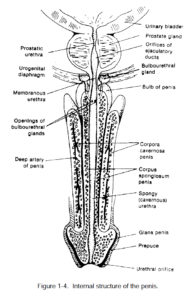a. Penis. The penis is the male organ of copulation and urination.
In the reproduction process, the penis is used to introduce sperm into the vagina.
(1) Glans. The terminal, enlarged end of the penis is called the glans. (The word glans means shaped like an acorn.) This portion of the penis is formed by that part of the spongy body which extends beyond the cavernous bodies of the penis shaft. The glans is highly innervated (tactile).
(2) Shaft. The shaft of the penis is made up of three cylindrical masses of tissue bound together by fibrous tissue. The two back and side tissue masses are called the corpora cavernosa penis. The smaller, third tissue mass is the corpus spongiosum penis, located toward the middle of the shaft and containing spongy urethra.
(3) Erection. These three tissue masses are erectile (capable of erection) and contain blood sinuses (channels). When sexually stimulated, the arteries of the penis dilate. Large quantities of blood enter the blood sinuses. Expansion of these spaces compresses the veins, draining the penis and causing most blood entering to be retained. An erection is caused by these vascular changes, the erection being a parasympathetic reflex. When the arteries constrict and the pressure on the veins is relieved, the penis returns to its flaccid (soft, limp) state.
b. Scrotum.
(1) Description/information. The scrotum is a two-layered sac that looks like an outpouching of the abdomen.
This sac encloses the testes and the lower part of the spermatic cords. Externally, the scrotum looks as though it is divided into two portions by a ridge (the raphe). Internally, the scrotum is divided into two sacs by a septum, each sac containing a single testis. There are smooth muscles in the walls of the scrotum.
(2) Temperature regulation inside the scrotum. The smooth muscles in the scrotum walls regulate the temperature in the testes where sperm are produced and stored.
These smooth muscles contract when it is cold, bringing the testes closer to the warmth of the body. When it is hot, these same muscles relax, moving the testes away from the body to be cooler. For sperm to be produced and survive, the temperature in the testes must be lower than the temperature of the body. Since the scrotum is outside the body, its internal temperature can be kept lower than the internal temperature of the body. The temperature inside the scrotum is about 3 degrees F below body temperature.

